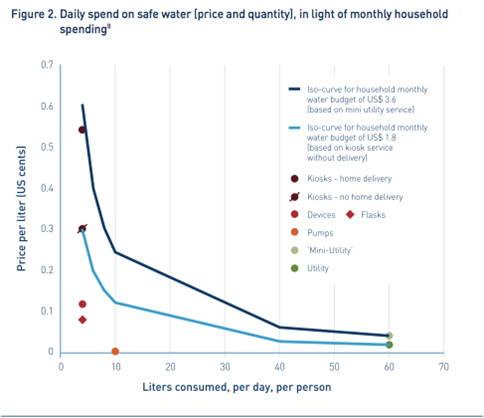Editor's Choice, April 2012: Entrepreneurial models for safe water at the base of the pyramid
How are entrepreneurs providing safe water to people at the base of the pyramid? What types of solutions, what business models, and how can they scale?
These questions are well addressed in this month’s Editor’s Choice: Access to Safe Water for the Base of the Pyramid; Lessons Learned from 15 case studies.
While public water provision serves well the needs of many urban populations, there are still 2 billion who lack access to safe water. This report looks at the diversity of entrepreneurial solutions that are increasingly reaching these households.
If there was any doubt about whether water can be a commercial proposition at the base of the pyramid, one look at their graph on spend per litre, gives a clear answer; the smallest water consumers spend much more per litre.

Four different types of clean water initiative are studied:
- Pumping and harvesting: Installations to pump underground water or collect rain water, such as protected wells.
- Devices, flasks and tabs: Consumable disinfectant products (liquid or tablet), and filtration devices, often used at home.
- Plants and kiosks: Mini-water-treatment stations, serving a small town or village.
- Piped distribution networks: to transport treated water to homes or public stand posts, large-scale or small.
The report provides excellent insight on how these models have been adopted and adapted across the developing world. And what more needs to be done – by business, by facilitators and governments - to help them reach scale.
Some fine grain detail is there, useful for any business operating in this space. The analysis is based on a review of 140 water initiatives, interviews with 110 entrepreneurs, and more detailed collaborative investigation of 15 water businesses.
The high-level re-thinking of direction is also clear. What the poor really want – and will pay for - is affordable piped water. But despite significant advances in technology and operational effectiveness, there is no large-scale proven model that combines a kiosk with a piped-water network at a price that is sufficiently low for the BoP (while still allowing for recovery of investment and operational costs without any major form of subsidies). The authors call for for a BoP-adapted operating model based on a ‘rethink’ of the mainstream utility paradigm. This would be based on consolidated clusters of independent, and versatile, small modular networks.
For the other solutions, that depend on individual water management and behaviour, they call for more investment in understanding how social marketing can be more effective, and truly sustainably influence behavior at scale.
This report is timely. The latest update on access to water and sanitation has just been released in the joint UNICEF-World Health Organisation 2012 Update: Progress on drinking water and sanitation. The welcome and refreshing news is that one Millennium Development Goal,Target 7c, to reduce by half the proportion of people without sustainable
access to safe drinking water and basic sanitation, has already been met. Since 1990, more than 2 billion people have gained access to improved drinking
water sources. But the more sobering news is that 780 million more remain without. And in sanitation, progress is slower with the world still off track to meet its sanitation target.
So the UN’s latest update, based on a massive data set and monitoring programme, sets the context for business innovation.
Further details
This wellspring of innovation reflects our own experience in the BIF and IAP Portfolios – with 5 projects approved for support in either water or sanitation sectors (with more so far in sanitation than clean water supply). See:
- Calimera safe water distribution in Tanzania: selling bottled water.
- Waste Ventures India; incubating four small-scale waste management companies owned and operated by waste pickers.
- Slum toilets in Kenya, Sanergy: building a network of low-cost sanitations units.
- 3S Shramik: rolling out Portable Toilet Cabins on a fee-based revenue model